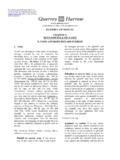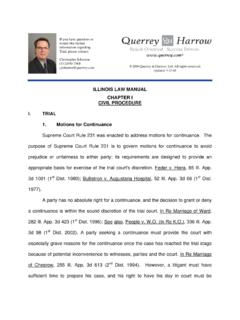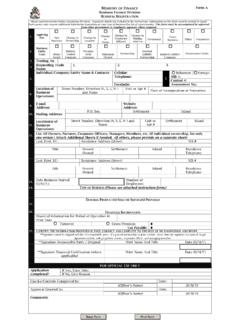Transcription of ILLINOIS LAW MANUAL CHAPTER II NEGLIGENCE - Querrey
1 If you have questions regarding NEGLIGENCE , please send an email One of our attorneys will contact you.. 2012 Querrey & Harrow, Ltd. All rights reserved. ILLINOIS LAW MANUAL . CHAPTER II. NEGLIGENCE . NEGLIGENCE --or the breach of a duty of care distinct questions of public policy, arise in proximately resulting in damage--was scarcely NEGLIGENCE cases versus those involving intentional recognized as a separate tort before the early 19th torts. Century. Trespass to land or damage to personal property, along with intentional torts, were the core A. ELEMENTS OF NEGLIGENCE . of civil law for centuries before. Gradually, however, social and cultural progress resulted in NEGLIGENCE is the failure to do something which a less emphasis on property rights and greater reasonably careful person would do, or the doing emphasis on personal rights. Therefore, for more of something which a reasonably careful person than a century, NEGLIGENCE has been recognized as would not do, under similar circumstances.
2 An independent basis of liability. Williams v. Conner, 228 Ill. App. 3d 350, 364 (5th Dist., 1992); ILLINOIS Pattern Jury Instructions Civil One of the earliest appearances of what we now Each person has a duty to use ordinary care recognize as NEGLIGENCE involved those who so that he does not cause injury or damage to professed to be competent in certain "public others. Similarly, every person has a duty to use callings." Common carriers, innkeepers, black- ordinary care for his own safety and for the safety smiths, attorneys, and surgeons were regarded as of his property. ILLINOIS Pattern Jury Instructions holding themselves out to the public as ones in Civil Second No. whom confidence might be placed. Thus, one assuming an obligation to give proper service in a In order to recover for NEGLIGENCE , a plaintiff must public calling could be liable for NEGLIGENCE in the plead and prove that: conduct of that service. The Law of Torts, Dan B. Dobbs, p.
3 260-261. The early cases were concerned (1) A duty was owed to the plaintiff by almost exclusively with positive acts rather than the defendant;. failures to act. Gradually, due to the nature of the relations between parties, a certain relationship (2) Injuries or damages were sustained by might be said to give rise to an obligation and legal the plaintiff; and duty to take affirmative action to avoid harm or injury. Thus, liability for omissions gained a (3) Defendant's breach of the duty owed greater recognition as a social obligation. to plaintiff was the proximate cause of plaintiff's injuries or damages. Around the year 1825, NEGLIGENCE came to be recognized as a separate and independent basis of Dinkins v. Ebbersten, 234 Ill. App. 3d 978, 983. tort recovery. Intentional torts, whether direct or (4th Dist. 1992); Thompson v. County of Cook, indirect, were recognized as distinct theories of 154 Ill. 2d 374, 382 (Ill. 1993); ILLINOIS Pattern Jury liability.
4 NEGLIGENCE remained the main basis for Instructions Civil The failure to prove any unintended injuries. Today, there is no dispute that one of the elements is fatal to a plaintiff's cause of separate problems and principles, as well as action. ILLINOIS Pattern Jury Instructions Civil Proximate cause consists of two elements: (1). actual cause; and (2) legal cause. Mengelson v. Ingalls Health Ventures, 323 Ill. App. 3d 69, 75. 1. Duty (1st Dist. 2001). When determining whether a defendant's conduct is the actual cause of an injury, Whether a duty exists and, if so, the nature of that a "but for" analysis is applied. Price v. Phillip duty must be determined by the courts as a matter Morris, Inc., (Ill. 2005). The question is whether of law. Marshall v. Burger King Corp., 355 Ill. the injury would have occurred but for the App. 3d 685, 688 (2d Dist. 2005). The relationship defendant's conduct. Id. at 269. If the injury would of the parties to each other determines the duty have occurred even absent the defendant's owed by one to another.
5 Ziemba v. Mierzwa, 142 conduct, then there is no actual causation and, Ill. 2d 42, 47 (Ill. 1991)(stated in dicta). In accordingly, no proximate causation. Id. Proximate determining whether a duty exists under given cause is not established where the causal circumstances, a court will consider the likelihood connection is contingent, speculative, or merely of injury, the foreseeability of that injury, the possible. Mengelson, 323 Ill. App. 3d at 75. magnitude of the burden of eliminating or guarding against the risk, and the consequence of placing Once actual cause is established, the next question that burden on the defendant. Kirk v. Michael is whether the defendant may be held legally Reese Hospital & Medical Center, 117 Ill. 2d 507, responsible. That is, was the defendant's conduct 526 (Ill. 1987); Largosa v. Ford Motor Company, the legal cause of the injury? Legal cause is a more 303 Ill. App. 3d 751, 754 (1st Dist. 1999). The imprecise concept than actual cause.
6 In order for a question of whether a duty exists is ordinarily a defendant's conduct to be the legal cause of an question of law for the court to decide. injury, the injury to the plaintiff must be reasonably foreseeable when the act or omission 2. Breach of Duty occurs. Watson v. Enter. Leasing Co., 325 Ill. App. 3d 914 (1st Dist. 2001). An individual breaches a duty when he or she fails to comply with the applicable standard of care. In There can be more than one proximate cause of other words, in the vast majority of cases involving any injury. Id.; see also Countryman v. County of ordinary NEGLIGENCE (as opposed to professional Winnebago, 135 Ill. App. 3d 384, 392 (2d Dist. NEGLIGENCE ), a party breaches his duty if he fails to 1985). When there is more than one proximate use reasonable care. Whether a duty has been cause of an injury, one who is negligent cannot breached is ordinarily a question of fact for a jury avoid liability merely because another person to decide.
7 Yager v. ILLINOIS Bell Telephone Co., negligently contributed to cause the same injury. 281 Ill. App. 3d 903, 908 (4th Dist. 1996). This is true even though the injury would not have occurred but for the NEGLIGENCE of the other person. 3. Causation Turner, 193 Ill. App. 3d at 492; see also Sears v. Kois Bros. Equipment, Inc., 110 Ill. App. 3d 884, Whether a person's conduct has proximately 889 (1st Dist. 1982). A negligent defendant can, caused another's injury is also normally a question however, avoid liability for a plaintiff's injury if of fact for the jury to resolve. Turner v. Roesner, another's conduct breaks the causal connection 193 Ill. App. 3d 482, 489 (2d Dist. 1990). The between the injury and the defendant's original claimed injury must be the natural and probable NEGLIGENCE . Quintana v. City of Chicago, 230 Ill. result of the negligent act or omission, and be of App. 3d 1032, 1034 (1st Dist. 1992). such a character as to have been a foreseeable result of that NEGLIGENCE .
8 However, it is not The causal connection between a defendant's essential that the person charged with NEGLIGENCE NEGLIGENCE and a plaintiff's injury is broken if a should have foreseen the precise injury which third party causes the injury and the third party's resulted from his act or omission. Williams v. conduct is unforeseeable. Oakley Transport, Inc. v. University of Chicago Hospitals, 179 Ill. 2d 80, 87 Zurich Ins. Co., 271 Ill. App. 3d 716, 725 (1st Dist. (Ill. 1997). 1995) (applying the law to an insurance coverage -2- dispute). For example, a criminal act committed by example, assume a pedestrian is injured in an a third party which causes a plaintiff's injury is automobile accident, fracturing her leg and unforeseeable and is ordinarily a superseding cause suffering internal damage. The plaintiff is treated which breaks the causal connection between the at the hospital and subsequently suffers additional injury and any original NEGLIGENCE .
9 Rowe v. State injuries due to negligent medical care. The plaintiff Bank of Lombard, 125 Ill. 2d 203, 224 (Ill. 1988). may sue the driver of the automobile that struck her and caused the initial injury, as well as the Another example of when a negligent party may negligent physician. In that case, the driver may be not be liable is when the defendant's NEGLIGENCE held liable for proximately causing the original merely furnishes a condition and is not an actual injuries. Gertz v. Campbell, 55 Ill. 2d 84 (Ill. cause of the injury. Quintana, 230 Ill. App. 3d at 1973). However, liability for a third-party 1036-37. An example of a condition resulting from plaintiff's damages should be apportioned on the NEGLIGENCE is where a municipal defendant basis of the relative degree to which the third-party negligently fails to repair broken signal lights at an defendant's conduct proximately caused of the intersection. Quintana, 230 Ill. App. 3d at 1033-34. plaintiff's injuries.
10 Skinner v. Reed-Prentice If two motorists subsequently collide because they Division Package Machinery Co., 70 1, 14. disobey the traffic code and fail to yield at an (1977); See also Joint Tortfeasor Contribution Act, intersection with non-functioning signals, then 740 ILCS 100/2. their failure to yield, not the lack of signals, may be the proximate cause of the accident. Id. at 1037. Another example illustrates the necessity of In other words, the lack of signals merely proving all of the elements of NEGLIGENCE . Assume furnished a condition for the NEGLIGENCE of the a plaintiff was involved in an automobile accident drivers to cause injury. Id. and retained an attorney to file a personal injury lawsuit. The attorney subsequently fails to file the The issue of proximate cause is generally a lawsuit within the applicable statute of limitations. question of fact to be determined by the finder of The plaintiff may sue his attorney for legal fact from all of the attendant circumstances.









